The day after Mara and I finished putting the last coat of polyurethane on the new stair treads, I walked through the front door and paused to admire our work. The treads looked great – smooth and flat with a subtle glowing sheen. But my attention was inevitably drawn to the baseboard that runs along the wall adjacent to the stairs. Now that the treads were clean and new, the baseboard looked like a pile of crap in comparison. Over the past 160 years, it had been slathered in coat after coat of thick, drippy paint, and now the top few layers of paint were cracked, chipped, and bubbling. Here’s a picture of the baseboard taken last year, before we began renovating the stairwell. Unfortunately, it still looked like this at the beginning of last week.
I’d been putting off dealing with the baseboard for months. Even setting aside the obvious aesthetic issues, I knew that the existing paint on the baseboard was too degraded to simply paint over it. If it weren’t covered in countless layers of lead paint, I could scrape off the old, loose paint and add a coat of fresh paint. But since lead paint is poisonous, scraping or sanding it isn’t a good idea, particularly with a toddler living in the building. On the other hand, doing nothing wasn’t a great option either since lead paint chips were flaking off the baseboard at an alarming rate. The only real solution was to remove all of the old paint using a wet, chemical stripping method, which would avoid spreading lead dust and paint chips all over the stairwell.
If you’ve ever tried to strip paint from old trim or doors, you know it’s a long, messy slog. There are a few different ways to go about stripping paint, each with advantages and disadvantages, but they all come down to finding a way to dissolve multiple layers of old paint. And since paint is specifically designed not to dissolve under normal conditions – if you could remove dried paint with soap and water it wouldn’t be very good paint – this is no easy task. I’m a chemist by profession, so I thought a lot about the chemistry of paint strippers as I researched different ways to remove the old paint from the baseboard. (A word of warning before we go on, if you’d rather watch paint dry than read about paint stripper chemistry, you might want to skip down a few paragraphs.)
The most obvious way to dissolve something is to find the right solvent, and for paint, that usually means methylene chloride. Methylene chloride-based paint strippers work really well – I’ve successfully used them to strip furniture in the past – but unfortunately, methylene chloride boils around 100 ºF (40 ºC), which means it releases a lot of fumes, even at room temperature. It also has a nasty habit of eating through latex and nitrile gloves; you need special PVA-coated gloves, which aren’t readily available at most stores. Even worse, the EPA classifies methylene chloride as a probable carcinogen. And even worse still, it’s also acutely toxic – without good ventilation, it’s possible to inhale a dangerous amount of methylene chloride vapor without realizing it (most construction masks don’t block solvent vapor). There have been a number of terrible, tragic cases of people dying while using methylene chloride based paint stripper indoors. (Seriously, don’t use methylene chloride strippers indoors.) For this reason alone, I ruled out using methylene chloride to strip the baseboard.
Another common way to dissolve something is to heat it up. If you’ve ever made simple syrup, you know that you can dissolve a lot of sugar in a small amount of water if you boil the water first. The same goes for paint. Heat guns, which are sort of like really high-powered hair dryers, are commonly used to heat old paint until it begins to melt and bubble away from the underlying wood, at which point it can be scraped away before it cools and re-solidifies. Heat guns make it easier to scrape off old paint, but, in the end, you still have to manually scrape off all of the paint. Plus, heat guns are apparently something of a fire hazard. They get hot enough that they can ignite embers, which sometimes smolder unseen in the crevices of wood trim or clapboards for hours before sparking a full blown house fire.
I actually own a heat gun – I used it to remove old window glazing putty – and I thought about using it to strip the baseboard, but in the end, I found a safer, easier method: a pH-based stripper. When you brush water at a neutral pH on old paint, nothing happens. But if you up the pH of the water a lot, making it highly basic/alkaline, it begins to eat away at the paint. The alkaline water actually reacts with the paint on a molecular level, liquefying it by breaking it down into smaller bits that dissolve in water.
One of the few commercially available pH-based strippers is a product called Peel Away 1. It’s essentially a water-based sodium hydroxide paste, so it doesn’t produce any fumes and shouldn’t have much of an odor. It has the consistency of butter cream frosting, which means it sticks to vertical surfaces, unlike most chemical strippers – a definite plus given that the baseboard is decidedly vertical. And at $34 a gallon it doesn’t break the bank. I decided to give it a try.
I cracked open the bucket and read through the instruction pamphlet inside. Slather a thick layer of stripping paste on the painted surface using a plastic spatula, cover it with the included wax paper, wait 24 to 48 hours, and scrape off the wax paper, stripping paste, and old paint in one easy sheet. Wash off the residue with water, let everything dry out overnight, and neutralize the stripped wood with the included citric acid. Seemed easy enough. I started with a test patch on the baseboard at the bottom of the stairs.
As I started spreading the paste on the baseboard, it seemed to have a thinner, drippier consistency than I expected. It was hard to apply a thick layer of paste without it beginning to dribble down toward the floor. Eventually I realized what was going on. I had bought the bucket of Peel Away about six months earlier and was only now getting around to using it. The Peel Away paste is mostly sodium hydroxide, and sodium hydroxide is hydroscopic, meaning it has a habit of pulling water vapor out of the air. In fact, it’s so hydroscopic that it deliquesces, pulling so much water from the air that it begins to dissolve into a soupy mixture. In the 6 months since I bought it, it seemed that the Peel Away paste had absorbed enough water that it had thinned itself out. I did my best to apply the now soupy paste to the baseboard, covered it with wax paper and left it for 24 hours.
The next day, I slid a plastic spatula behind the wax paper and paste, which had dried out and firmed up, and the whole mess sloughed off in one piece, as advertised. I was left with this.
Unfortunately, there were at least three layers of old paint left behind. The soupy Peel Away must have been too thin to eat through the last of the paint. But these three layers of paint were interesting in their own right. Who knew that the stairwell trim was olive green at one point, and dark brown (faux wood finish?) before that? Since I’ve already begun painting the stairwell trim white, I was relieved to find that the original paint color was also white. It would be disappointing to go through all of the trouble of removing a century-and-a-half’s worth of paint and restoring the baseboard to it’s original splendor only to find that the building’s architect had originally intended for the trim to be painted green or dark brown.
Since my old, thinned-out Peel Away didn’t seem to be cutting it, I went back to the paint store and picked up a fresh bucket. The consistency of the fresh paste was much pastier, similar to joint compound. Rather than re-testing the fresh stripper on a small patch of baseboard, I just decided to go for it and coated the entire thing in a thick layer of paste.
Will the original wood surface of the baseboard see the light of day for the first time in 160 years? Or will I be left with a mess of old, splotchy, half-stripped paint? Tune in next time to find out what happens when I scrape off the Peel Away.
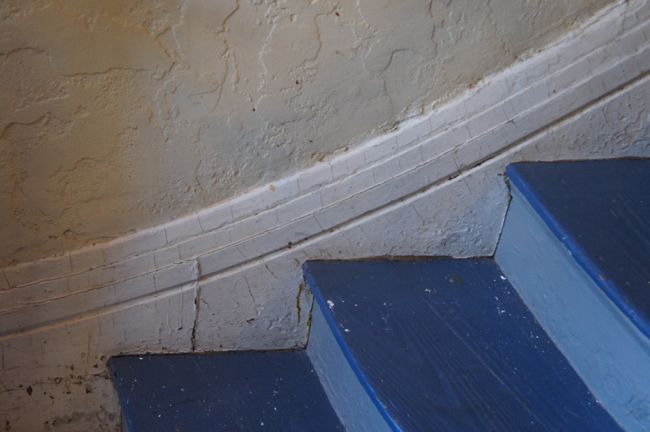
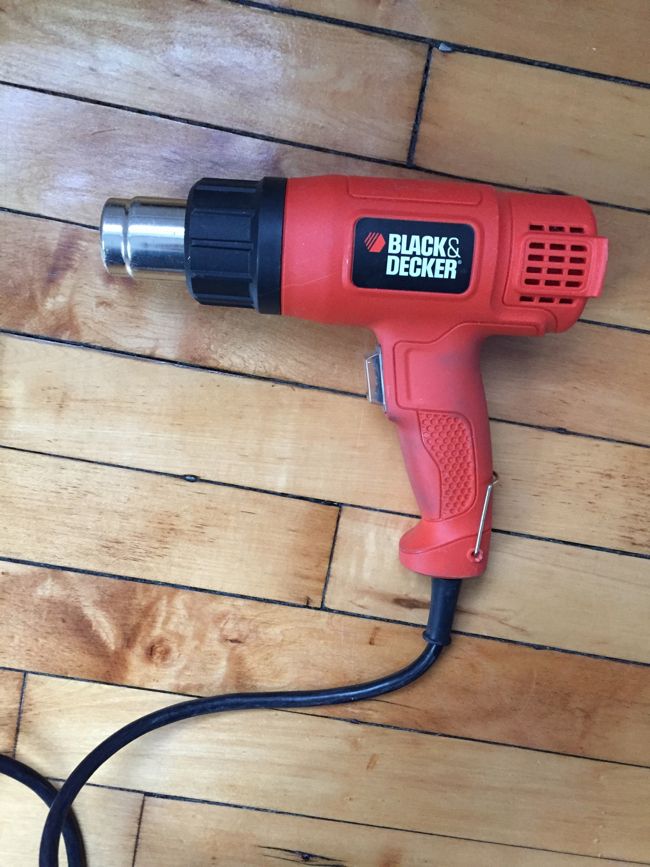
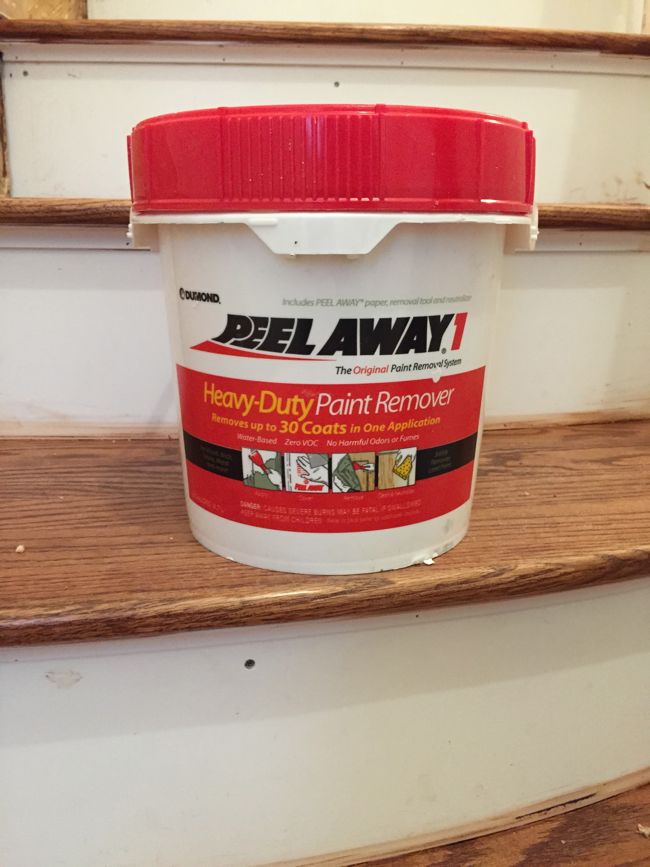
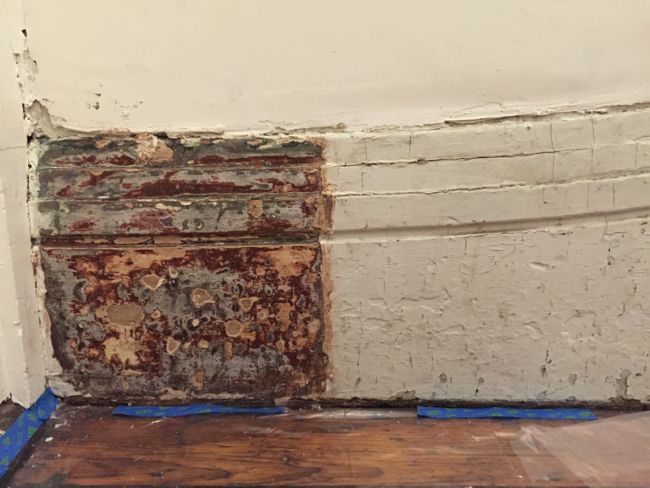
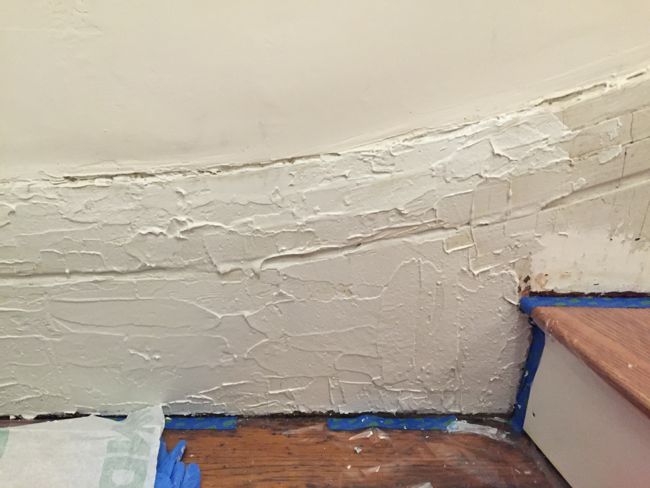
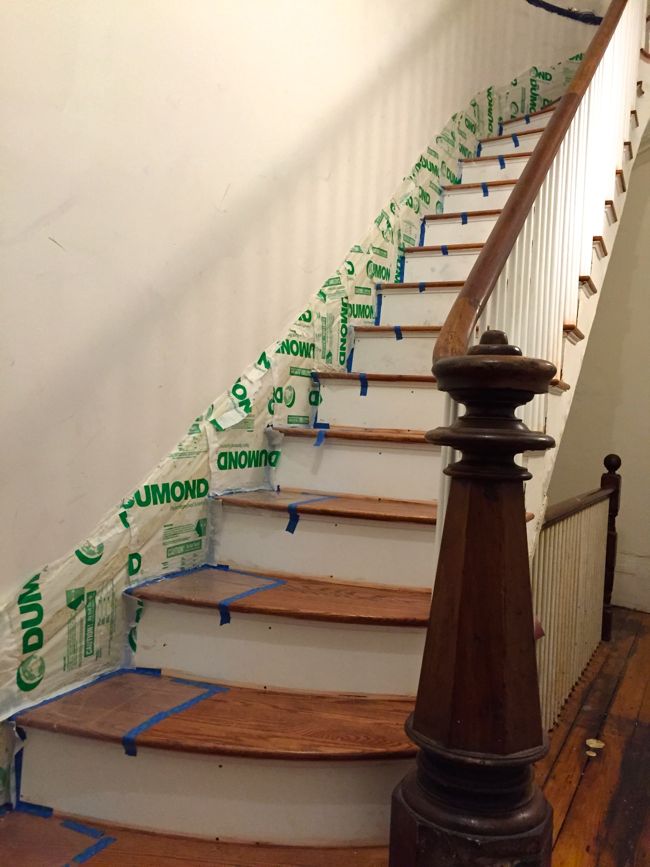
Oh I am so anxious to see how the peel away works. I have used the other super smelly stuff with special gloves, outdoors, and it works…but i hate it. So am keeping my fingers crossed you had good luck with this product.
I was curious how you would deal with the baseboards. I thought about it when you were putting the finish on the steps…i kept thinking about stripper dripping down and ruining your beautiful steps. I wondered why you had not done the baseboards first. I see in your picture that you have well protected your steps! This entire project will be so wonderful when finally finished.
In retrospect, stripping the baseboard before refinishing the steps would have made a lot of sense. But since refinishing the steps involved coordinating with the neighbors, the timing didn’t work out. Now I’m just hoping that taping off the new treads will be enough to keep them from getting stained by the paint stripper!
Oh, the suspense!! I too, wondered how you’d tackle the tricky job of refinishing the baseboard while protecting the steps, and why you didn’t do it before finishing the steps. Thanks for answering that question. I’ve never seen Peel Away before, so I’m glad to see it in action at your place. I have some doors that I’m thinking of stripping next summer, and this might be the way to go because I don’t like using the toxic stuff around our pets.
I also have several doors that could stand to be stripped. Since I can take the doors outside to strip them, I’m thinking either the heat gun or Peel Away or some combination of the two would be the best option. I’m also looking into the cost of sending them out to be professionally stripped — taking into account the cost of the stripper and the hours I’d likely spend scraping every last bit of paint off the doors, it might actually be less expensive to have someone else do it.
Lucky me! I get a new post from you and Manhattan Nest on the same day. A vicarious DIYers dream!
Can’t wait to see how good the stairs look when they are all done.
Thanks Marika! Although the scope of the latest Manhattan Nest post makes me feel lazy for writing an entire post about choosing a paint stripper.
Who knew stripping paint from baseboards could be so exciting/suspenseful but it is! You’re a really great writer and I appreciate your attention to detail, thoughtfulness and ability to explain situations concisely. I can’t wait to see the results!
Thanks Sara, I’m excited to see how this turns out too. One way or another I’m determined to get all of the paint off this baseboard — I’m sure it’ll be a huge improvement.
I’m so glad that I have the name of this stripping product. I have had my share of those toxic ones! Did this one do the trick?…….I will stay tuned to see!
Professional “dipping” services use alkaline water baths to strip paint, the same active ingredient as Peel Away, so it should work in principle.But there are dozens of layers of paint on the baseboard, so we’ll have to see how effective it really is.
It’s also worth mentioning that even though Peel Away doesn’t smell or give off fumes, you still need to wear gloves and safety glasses when using it since it can irritate your skin pretty badly and even worse things can happen if it gets in your eyes.
I can’t believe you are doing this to us!! What is going to happen next?!!!! 😀
I’ll try not to keep you in suspense for too long!
The people want more! I’m dying over here to know what happens next. Also, I’ve been a lurker since I started reading your renovation diaries on Apartment Therapy, but I just wanted to let you know that I love the way you write about your process. Keep up the good work!
Sorry to keep you in suspense! Check back later today; I’m going to try my best to post the dramatic conclusion to the paint stripping saga tonight. And thanks for following along!